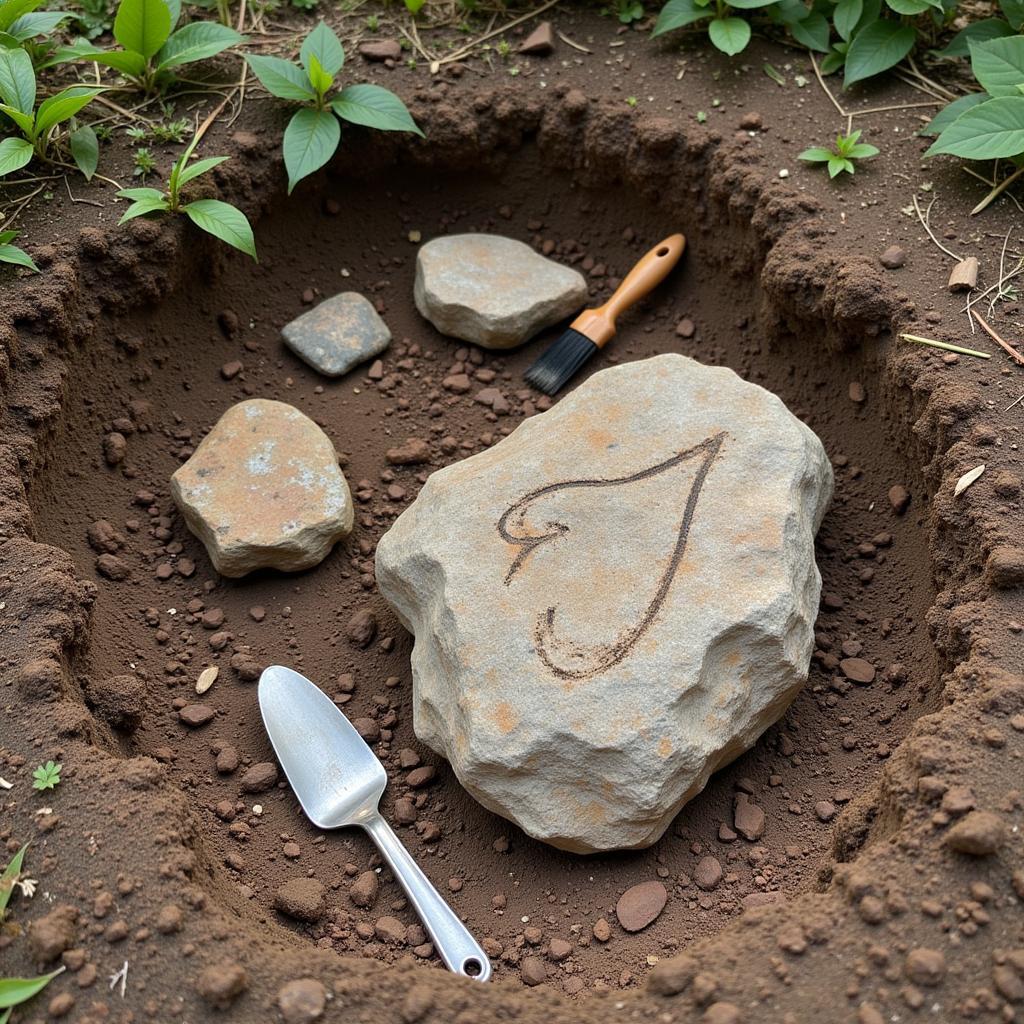Portable Rock Art Found in Missouri and Arkansas
Portable rock art, encompassing carved stones, engraved pebbles, and painted cobbles found in Missouri and Arkansas, offers a unique window into the lives and beliefs of past cultures. These fascinating artifacts, unlike the large, immobile rock art panels often studied, were easily transported and likely served a variety of purposes, from personal adornments to ceremonial objects.
Exploring the Meaning of Portable Rock Art
What can these small, intricate pieces tell us about the people who created them? Portable Rock Art Found In Missouri And Arkansas often features abstract geometric designs, animal motifs, and occasionally, human-like figures. These symbols likely held significant meaning, potentially representing clan affiliations, spiritual beliefs, or even narratives of important events. Researchers analyze these patterns, comparing them to other archaeological findings and ethnographic data to decipher their potential messages.
One fascinating aspect of portable rock art is its inherent mobility. Unlike large rock art panels that are fixed to a specific location, these smaller pieces could be carried, exchanged, and used in various contexts. This suggests a dynamic social network, where ideas and objects were shared across communities. Imagine these pieces being passed down through generations, each generation adding their own layer of meaning and significance to the object.
Identifying Portable Rock Art in Missouri and Arkansas
How can you distinguish a piece of portable rock art from a naturally weathered stone? While some pieces are clearly carved or painted, others may be more subtle. Key indicators of human modification include repetitive patterns, deliberate incisions or peck marks, and the presence of pigment residues. It’s important to note that not all modified stones are necessarily “art.” Some may have served practical purposes as tools or gaming pieces. The context in which the stone is found, along with the presence of other artifacts, can offer valuable clues.
It’s crucial to treat any potential portable rock art with care. Avoid disturbing the site or removing the object. Documenting the find with photographs and GPS coordinates is essential for preserving the archaeological context. If you believe you have discovered a significant piece, contact local archaeological authorities or a nearby university. Your discovery could contribute significantly to our understanding of the past.
 Identifying Portable Rock Art In Situ in Missouri and Arkansas
Identifying Portable Rock Art In Situ in Missouri and Arkansas
Portable Rock Art and its Connection to Larger Rock Art Sites
Are there connections between portable rock art and the larger, more prominent rock art panels found in the region? Researchers are exploring the potential relationships between these two forms of expression. Similarities in motifs and stylistic elements suggest a shared visual vocabulary. It’s possible that portable rock art served as a smaller, more personal version of the larger, communal panels, allowing individuals to carry aspects of their shared beliefs and traditions with them.
Dr. Amelia Stone, a leading archaeologist specializing in rock art of the Ozark Plateau, states, “Portable rock art provides a tangible link to the individual experiences of those who lived in the past. These objects offer a glimpse into their daily lives and the stories they held dear.”
Conclusion
Portable rock art found in Missouri and Arkansas provides a valuable glimpse into the past. These small but significant artifacts offer insights into the beliefs, practices, and social interactions of past cultures. By studying these objects, we can better understand the lives of those who came before us and connect with their stories. If you encounter portable rock art, remember to document and preserve it responsibly, contributing to the ongoing effort to unlock the secrets of our shared heritage.
FAQs
-
What is portable rock art? Portable rock art includes any form of rock art that can be easily carried, such as carved stones, engraved pebbles, and painted cobbles.
-
Where can portable rock art be found? Portable rock art has been found throughout the world, including in Missouri and Arkansas.
-
What is the significance of portable rock art? Portable rock art provides insights into the beliefs, practices, and social interactions of past cultures.
-
How can I identify portable rock art? Look for repetitive patterns, deliberate incisions or peck marks, and the presence of pigment residues.
-
What should I do if I find portable rock art? Document the find with photographs and GPS coordinates and contact local archaeological authorities.
-
How is portable rock art related to larger rock art panels? Researchers are exploring potential connections, including shared motifs and stylistic elements.
-
Who studies portable rock art? Archaeologists and other researchers specializing in rock art and prehistoric cultures.
Need further assistance? Contact us at Phone Number: 02462573573, Email: danteum@gmail.com or visit us at Savico Megamall, 7-9 Đ. Nguyễn Văn Linh, Gia Thụy, Long Biên, Hà Nội 10000, Việt Nam. We have a 24/7 customer support team.


